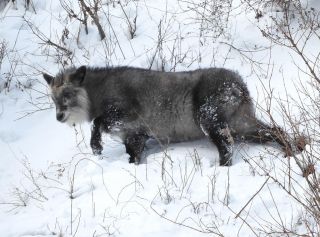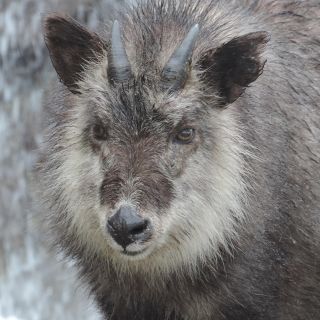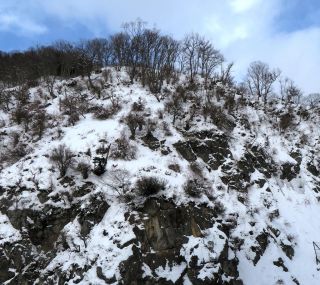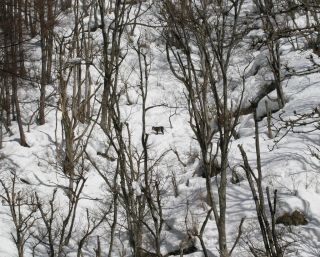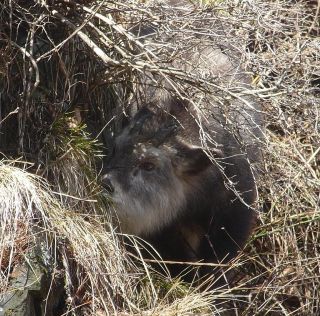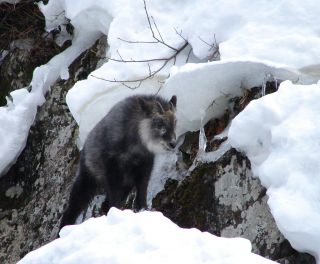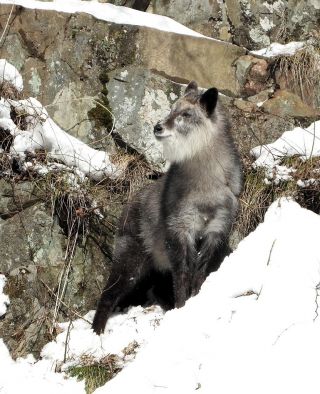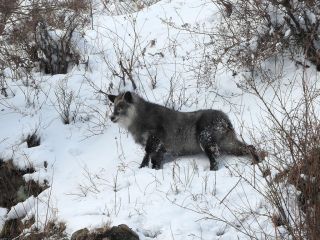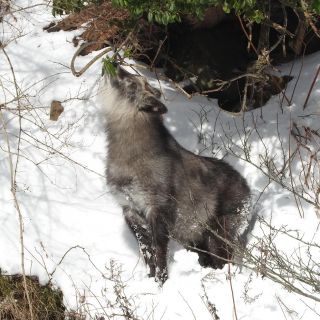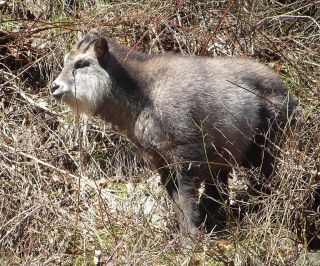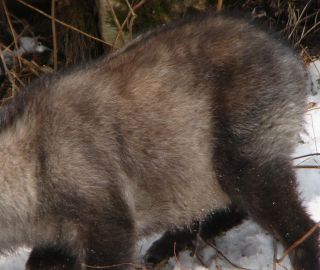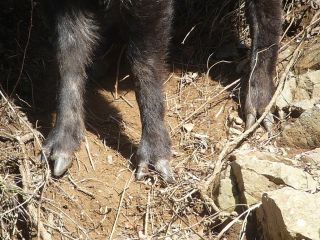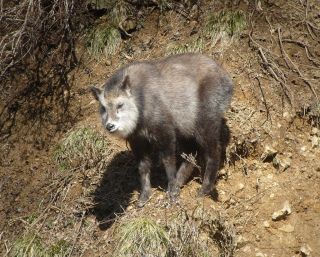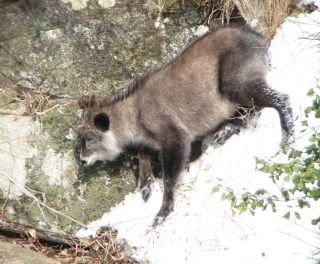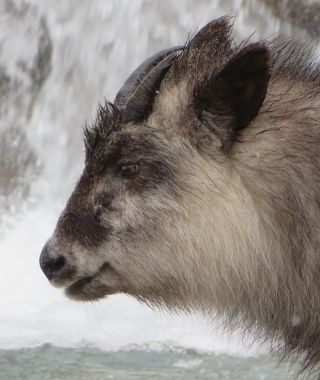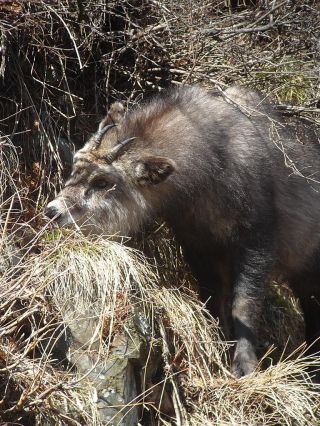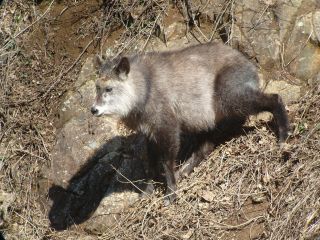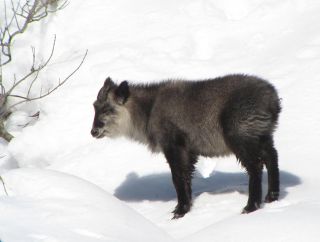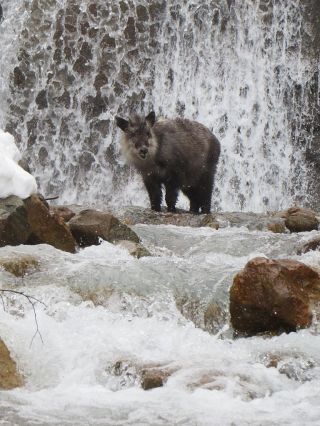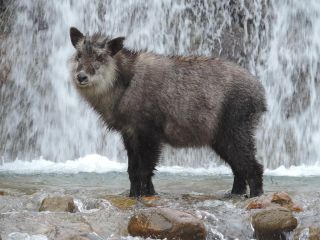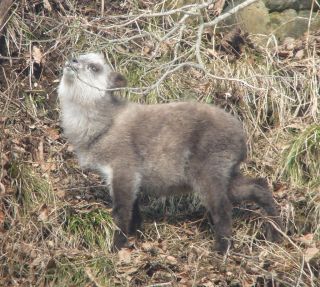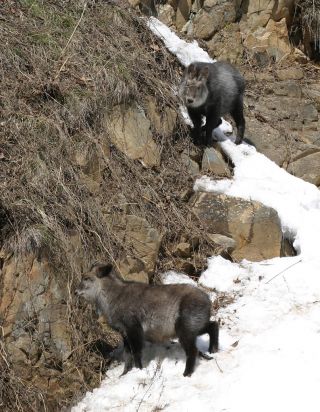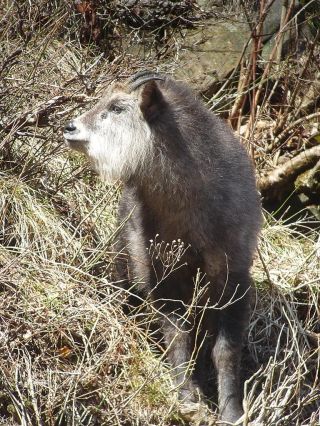Japanese Serow Capricornis crispus ploughing through snow in the mountains of Honshu © Mark Brazil
Searching for the Grey Ghost: Kamoshika
By Mark Brazil | Dec 31, 2016
Japan is a ghostly country, as readers of Lafcadio Hearn's “In Ghostly Japan” know full well. Ghosts may await us near temples, shrines and graveyards here, but one ghost, the Grey Ghost, haunts the mountains of Japan. Searching for the Grey Ghost requires a sharp eye, patience and persistence – or perhaps a lucky soak in an outdoor hot spring pool.
Some people might consider my penchant for birding in the buff as a bizarre fetish, but really there is no better way of appreciating the delightful sights and sounds of wildlife than from a hot spring – Japanese style, cozzie-less, of course. I’ve bathed my way the length and breadth of Japan in hot springs ranging from the humble to the grandiose, but nowhere do I revel more than where there is a rotenburo – a “bath beneath the heavens” – because it offers both bathing and the opportunities for watching wildlife in one.
I discovered such delights more than 30 years ago on Hokkaido’s Shiretoko Peninsula, and my story begins there, where the brown dipper I scored from the riverside pool Kuma-no-yu – “hotwater of the bears” – was soon overshadowed, literally, by a passing Steller’s Sea Eagle. We birders love to list, but instantly I gave up my life, country and year lists in favour of just one – my bath list. I have even studied my favourite birds – Whooper Swans – from the rotenburo.
The Bath Birding Club (the BBC, no less) is elite, exclusive and open only to the most dedicated, though so far it has only two other official members, my Tokyo-based British pal Chris Cook, and my Russian pal Sergey Frolov of Petropavlovsk-Kamchatsky, with whom bird-bathing can get no better. A session in a hot pool on one of the Kurile Islands gave me and Sergey a Wood Sandpiper, Peregrine Falcon, Harlequin Duck and, amazingly, a star of stars, the Whiskered Auklet – bathing birding bliss! Chris has since gone one better and scored a Copper Pheasant overhead while bathing in a remote hotspring in Honshu, a species I can’t imagine ever catching up.
These outdoor bathing sessions are not only for birders, however, and in more than 30 years of this hobby I’ve lost count of the shootings stars, and moon moths I’ve seen. Mammal sightings have been scarcer and so more memorable, such as the Japanese (Sika) Deer that trotted past me one wintery dawn, and the Red Fox that came to peer at me in my sanctuary of a nice hot pool in east Hokkaido, but I have discovered that Jigokudani tops the list for a mammal-watching soak. There, in the mountains of Nagano Prefecture in Central Honshu, beside a river and a rustic country lodge, is a very special pool. There I have taken to the waters both during the day and late at night – when moon-gazing, scudding snow clouds, and shooting stars are the most likely entertainment – but my favourite time is early in the morning when I have searched and searched for one mammal only – the endemic, elusive Japanese Serow. This stocky, ‘goat-antelope’ is a grizzled, frosty grey, and through the rising steam from the bath it is hard to spot on the snow-covered mountain slopes above the river. The serow is the grey ghost of Japan’s mountains, moving like a slow shadow, blending in against a background of rock, dry vegetation or dark patches amidst the snow.
Morning after morning, with my binoculars at hand, I have scanned the slopes looking for the slightest movement. I emerge from the heat of the pool from time to time to cool off, despite the sub-zero temperatures and deep snow, and only return to the therapeutic mineral waters when the cold begins to bite rather sharply at my nether regions. One dawn, I had just slipped back in to the pool and was beginning to warm up again, when I realized that a distant dark shadow above me on the hillside had moved. I grabbed for my binoculars – a serow! I was tempted to shout out loudly – “at last serow’s on my bath list”, but that would not have been within bathing protocol.
As the initial and immediate thrill of my sighting waned, I became subtly aware of movement behind me and of the subtle sound of someone else slipping into the bath. No doubt they thought me strange sitting chest deep in hot water but staring intently up at the snow-covered hillside through my binoculars while soaking. However, they said nothing and I carried on watching. The long-sought, distant serow seemed settled now and was nibbling at some exposed twigs, so I took the opportunity, turned and with the whispered words “There’s a serow, just over there” still forming on my lips, found myself face-to-face, not with a fellow naturalist, nor even an early-rising traveller, but with a large male Japanese Macaque enjoying his morning soak. Was I now on his bath list?
Japan is home to more than 100 species of mammals and while the likes of bears (Asiatic Black, and Brown), Japanese Macaque, Japanese Deer, and Red Fox are readily recognisable even to visitors, the rather strange creature that is the Japanese Serow, or Kamoshika, is rarely heard of outside Japan.
This extraordinary beast roams the mountains of Japan from the Shimokita Peninsula, at the northernmost limit of Honshu, to the mountains of eastern Kyushu. This primitive and elusive herbivore is found only here, making it a Japanese endemic species.
This grizzled grey ghost of Japan’s mountains is slow moving and solitary. It blends in so well against the backdrop of its habitat that seeing it is like trying to catch a will-o-the-wisp. A forested hillside that appears devoid of live and movement through hours of scanning suddenly presents a serow standing stock still in a clearing between the trees. How did it get there? Was it there from the beginning? Did it emerge from some hiding place, or perhaps from another, ghostly dimension.
Like forest wraiths, Kamoshika are silent, secretive wanderers, browsing through their forest territories, moving stealthily so as to not attract attention. Their coarse, ashy, grey-black hair, camouflages them well in the shady undergrowth of their preferred range. Their compact form and long fur causes confusion among first time viewers, with some mistaking them for wolves, others for bears and occasionally even for Wild Boar.
As if it were a creature in a medieval European bestiary, the Kamoshika has been variously described, and rather unflatteringly I feel, as a cross between a cow, a donkey, a pig and a goat! Such a poor description does scant justice to this extraordinary creature; but I can agree with the more common description of it as a “goat-antelope”, for glimpsed in the shady forest, or forging a way through deep snow, that is how it appears. It is surprising that they haven’t been dubbed the forest devil, for the serow’s head is topped with a pair of short, Satanic, prong-like black horns, tapering to sharp points. Strong ridges, or rings on the horns are indications of their age.
Allowing them to push through tangled vegetation, particularly wiry dwarf bamboo, and deep snow Kamoshika have powerful legs and a stocky, muscular body. Though seemingly physically well suited to their mountain habitat, they survive by browsing rather poor quality fare of leaves, herbs, and bamboos, and in winter they seem to survive on leaf buds and bark. They occupy a rather specific ecological niche in the montane forests of Japan, where, surprisingly, they share one habit with rhinoceroses and Tanuki (raccoon-dogs) and another with tigers! Like rhinos and Tanuki they deposit their droppings, not randomly like deer, but regularly in a latrine. Like Tigers, male and female serows have a particular style of overlapping home ranges.
The serow has a delicate face, with a long muzzle, and two weeping glands, just below its eyes, giving it a sorrowful expression, as if is constantly crying. They are quiet, solitary creatures on the whole. They move slowly, and deliberately, pushing through deep snow in winter and dense vegetation in summer, marking their territories as they go, by touching that extraordinary preorbital gland to twig tips and leaves in passing.
The very best way of looking for serow is to find a vantage point on one side of a steep valley and scan across to the other side, checking each shadow, each dark patch, each contrasting area of colour in case it is really a serow in disguise. Spotting serow even against a snow-covered hillside may take hours of scanning, but the rewards can be tremendous, for once found they will likely remain in the same area for hours at a time, rarely moving and seemingly saving energy during the low season for food by reducing their energetic demand. Their slow pace of life allows for prolonged views and an opportunity to soak in the details of their pelage, horns, facial glands, and particularly their feet. Though many other species (cattle, deer, goats, sheep for example) share cloven hooves, I know of no others that have such splayed toes. Their wedge-shaped toes splay widely affording them excellent grip on loose soil, snow or rocky terrain. They move as readily up or down alarmingly steep slopes and can be found standing on isolated knolls or nubs of rock where it seems unlikely that even the most avid of mountain hikers could reach.
Their dense, shaggy fur, short rounded ears, stocky legs and stout barrel body seem well adapted to the cold winters of their native home and the damp of the early summer rainy season and coldness of the typhoon rains in the mountains. On cold winter days, when snow clouds clear and the sun shines, they are sometimes to be found standing completely exposed flank presented to the sun with their dark, sooty-grey winter coat soaking up the sun’s warmth. Their thick coats seem to keep them so warm that on occasions they even overheat and I have seen them lying spread in the snow, or standing in what to me would be bone-chilling rushing streams quietly cooling off and ruminating.
Among Japanese Serows, males and females both occupy home territories, a patch of hillside and forest through which they roam, with the territories of one male overlapping those of several females. Scent marking allows them to keep track of each other and their movements. Males and females rarely meet, except during the October and November rut, and for the remainder of the year they go their separate ways, yet through those scent trails they must be aware of each other. Following the rut, the females give birth to their single, occasionally twin, calves during early summer, in May and June, during the time of plenty when herbs and flowers abound on the forest floor and bushes dangle tempting fresh foliage. If one encounters more than one serow at a time, then it is more than likely to be a female with her single or twin youngsters.
The Kamoshika has been protected as a natural monument since 1934, and as a special natural monument since 1955, but such paper protection does not prevent them coming into conflict with both humans and other animals. Their habit of chewing the bark of unprotected trees gets them into trouble with foresters who have not protected their saplings. At the same time their shy and retiring nature brings them into conflict now with another cloven-hoofed creature of Japan – the Japanese Deer.
As winters become milder and shorter in Japan, and as snow falls in the mountains become fewer and lighter, species of plants and animals less tolerant of deep snow and prolonged cold are able to move further up into the mountains. The Japanese Deer is one such species. As it expands its range upwards into montane forests it comes more frequently into contact with serow. Although they feed on rather different foods – Japanese Serows are essentially browsers, whereas Japanese Deer are grazers – and so might be considered non-competitive, in other ways they are in conflict.
Japanese Deer are social creatures, living in herds and as such they seem oblivious to the presence of serow. Unfortunately, serow are far more sensitive and when they encounter deer their tendency is to retreat, for them undisturbed space is a very valuable resource. While adult serows are occasionally aggressive towards deer, attempting to drive away the intruders from their territories, their offspring invariably retreat. This sensitivity towards disturbance, which pushes them to move away from areas into which deer have penetrated, is particular damaging because it leads to unsuccessful breeding. In particular, female serows disturbed during pregnancy are prone to still births, and the low birth rate in areas where deer are increasingly common has meant that serow populations are declining locally.
If you are determined to search for the Grey Ghost of Japan’s mountains, then find a secluded montane area with steep-sided valleys where snow lies deep in winter and where deer have not yet penetrated. Station yourself at a vantage point part way up one side of a valley, fortify yourself with warm drinks and a picnic and settle in for a long wait. While scanning the opposite valley slope carefully is crucial, don’t forget to look around, they may be behind you, and if they haven’t spotted you they won’t be disturbed and may wander into very close range. An excellent place to watch from is Bunaoyama Kansatsusha (ブナオ山観察舎) the “animal observatory house” at Bunao Yama, at Hakusan in Ishikawa Prefecture. While the building may be closed except at weekends and on holidays, the trail and hillside are open for viewing year round, but for serow the best season is after leaf fall in autumn and before spring flush blocks the view.
If you have read this far, then you may enjoy my previous articles, including recent offerings such as: Dancing with the Birds of Happiness (November 2016); Duck anyone? Mallard or Muscovite? (October 2016); Damsels and Dragons: Aerial Dancers (September 2016); Halcyon Days (August 2016); Isolated in the Izu Islands (July 2016); Japan’s Ubiquitous Scavenger – The Black-eared Kite (June 2016); Oriental Stork Making a Comeback in Japan (May 2016); Daijugarami: Stepping Stone to the Arctic (April 2016); Whale Watching Japan-style: Zamami (March 2016), Snow Monkeys & Cranes of Japan: Spectacular Winter Wildlife (February 2016), and Amami Night Safari (January 2016).
These Wild Watch articles, and many more, can be found on this website, and on our Facebook page (please do visit and hit the “Like” button).
Author, naturalist, lecturer and guide, Dr Mark Brazil has written his Wild Watch column continuously since April 1982, first in The Japan Times for 33 years, and since 2015 here on this website. All Wild Watch articles dating back to 1999 are archived here for your reading pleasure.
A collection of Mark’s essays The Nature of Japan and two handy pocket guides The Common and Iconic Birds of Japan and The Common and Iconic Mammals of Japan have been published and are also available from www.japannatureguides.com

